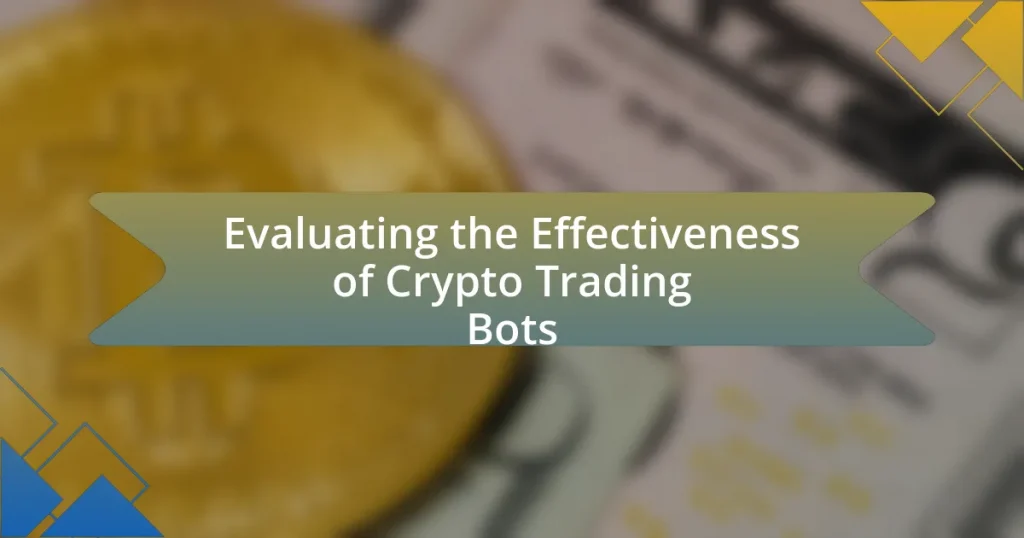Crypto trading bots are automated software programs designed to execute trades in cryptocurrency markets on behalf of users, utilizing algorithms to analyze market data and identify trading opportunities. This article evaluates the effectiveness of these bots by examining their operational mechanisms, the algorithms they employ, and the impact of market conditions on their performance. It also explores various types of trading bots, including arbitrage, market-making, and trend-following bots, while discussing key performance metrics such as return on investment (ROI) and risk management strategies. Additionally, the article addresses challenges in evaluating these bots and provides best practices for users to effectively assess their performance and make informed trading decisions.

What are Crypto Trading Bots?
Crypto trading bots are automated software programs that execute trades on behalf of users in cryptocurrency markets. These bots utilize algorithms to analyze market data, identify trading opportunities, and execute buy or sell orders based on predefined strategies. According to a report by the Cambridge Centre for Alternative Finance, the use of trading bots has increased significantly, with many traders leveraging them to enhance efficiency and capitalize on market volatility.
How do Crypto Trading Bots operate?
Crypto trading bots operate by utilizing algorithms to automate trading decisions based on market data and predefined strategies. These bots analyze price movements, trading volume, and market trends to execute trades on behalf of users, often at speeds and frequencies that are unattainable for human traders. For instance, a study by the Cambridge Centre for Alternative Finance indicates that algorithmic trading can significantly enhance trading efficiency and profitability by minimizing emotional decision-making and optimizing trade execution.
What algorithms do Crypto Trading Bots use?
Crypto trading bots primarily use algorithms such as Arbitrage, Market Making, Trend Following, and Machine Learning. Arbitrage algorithms exploit price discrepancies across different exchanges to generate profit. Market Making algorithms provide liquidity by placing buy and sell orders, profiting from the spread. Trend Following algorithms analyze historical price data to identify and capitalize on market trends. Machine Learning algorithms utilize data-driven approaches to adapt and optimize trading strategies based on market conditions. These algorithms are validated by their widespread use in the industry, demonstrating their effectiveness in executing trades efficiently and profitably.
How do market conditions affect Crypto Trading Bots’ performance?
Market conditions significantly influence the performance of crypto trading bots by affecting their ability to execute profitable trades. In volatile markets, trading bots may struggle to maintain consistent performance due to rapid price fluctuations, which can lead to slippage and increased transaction costs. Conversely, in stable market conditions, bots can more effectively utilize their algorithms to capitalize on predictable price movements, resulting in higher profitability. Historical data shows that during the 2017 cryptocurrency boom, many trading bots achieved substantial returns, while in the subsequent bear market of 2018, their performance declined sharply, illustrating the direct correlation between market conditions and bot effectiveness.
What types of Crypto Trading Bots exist?
There are several types of crypto trading bots, including arbitrage bots, market-making bots, trend-following bots, and portfolio management bots. Arbitrage bots exploit price differences across exchanges to generate profit, while market-making bots provide liquidity by placing buy and sell orders. Trend-following bots analyze market trends to make trades based on momentum, and portfolio management bots help users manage their investments by automatically rebalancing assets. Each type serves a specific trading strategy, enhancing efficiency and potential profitability in the cryptocurrency market.
What are the differences between arbitrage and market-making bots?
Arbitrage bots and market-making bots serve distinct functions in cryptocurrency trading. Arbitrage bots exploit price discrepancies across different exchanges by buying low on one platform and selling high on another, thereby capitalizing on the inefficiencies in market pricing. In contrast, market-making bots provide liquidity to the market by placing buy and sell orders around the current market price, earning profits from the spread between these orders.
The primary difference lies in their operational strategies: arbitrage bots focus on taking advantage of price differences, while market-making bots aim to facilitate trading by ensuring there are always buy and sell orders available. This distinction is crucial, as arbitrage requires rapid execution to capture fleeting opportunities, whereas market-making relies on maintaining a balanced order book to earn consistent profits over time.
How do trend-following bots function in trading strategies?
Trend-following bots operate by analyzing market data to identify and capitalize on prevailing price trends in trading strategies. These bots utilize algorithms that assess historical price movements and indicators, such as moving averages, to determine the direction of the market. When a trend is identified, the bots execute buy or sell orders to align with the trend, aiming to maximize profits as the price continues in that direction.
For instance, a study by F. Allen and D. Gale in “Comparative Financial Systems” highlights that trend-following strategies have historically outperformed traditional investment approaches during volatile market conditions, demonstrating their effectiveness in capturing upward or downward price movements.

Why evaluate the effectiveness of Crypto Trading Bots?
Evaluating the effectiveness of crypto trading bots is essential to ensure they deliver profitable trading outcomes. These automated systems utilize algorithms to execute trades based on market data, and their performance can significantly impact an investor’s returns. According to a study by the Journal of Financial Markets, trading bots can outperform human traders by analyzing vast amounts of data quickly and executing trades at optimal times. Therefore, assessing their effectiveness helps investors make informed decisions, optimize strategies, and mitigate risks associated with automated trading.
What metrics are used to assess the performance of Crypto Trading Bots?
The primary metrics used to assess the performance of crypto trading bots include return on investment (ROI), win rate, Sharpe ratio, maximum drawdown, and trading volume. ROI measures the profitability of the bot by comparing the net profit to the initial investment, while the win rate indicates the percentage of profitable trades out of total trades executed. The Sharpe ratio evaluates risk-adjusted returns, providing insight into the bot’s performance relative to its volatility. Maximum drawdown quantifies the largest peak-to-trough decline in the bot’s equity, highlighting risk exposure. Finally, trading volume reflects the total amount of assets traded, which can indicate the bot’s activity level and market engagement. These metrics collectively provide a comprehensive view of a trading bot’s effectiveness in the crypto market.
How does return on investment (ROI) factor into effectiveness evaluations?
Return on investment (ROI) is a critical metric in evaluating the effectiveness of crypto trading bots as it quantifies the profitability of investments relative to their costs. By calculating ROI, traders can assess how much profit or loss a trading bot generates compared to the initial investment, providing a clear indicator of its performance. For instance, if a trading bot yields a profit of $1,000 on an investment of $5,000, the ROI would be 20%, indicating a successful trading strategy. This metric allows users to compare different bots and strategies, facilitating informed decisions based on financial outcomes.
What role does risk management play in evaluating Crypto Trading Bots?
Risk management is crucial in evaluating crypto trading bots as it determines the bot’s ability to minimize losses and protect capital. Effective risk management strategies, such as setting stop-loss orders and position sizing, help assess how well a trading bot can handle market volatility and adverse conditions. For instance, a study by the CFA Institute highlights that robust risk management practices can lead to improved long-term performance and reduced drawdowns in trading strategies. Therefore, evaluating a crypto trading bot’s risk management capabilities is essential for understanding its overall effectiveness and reliability in real market scenarios.
What challenges arise when evaluating Crypto Trading Bots?
Evaluating crypto trading bots presents several challenges, primarily due to the volatility of cryptocurrency markets and the complexity of algorithmic trading strategies. The unpredictable nature of market fluctuations can lead to inconsistent performance metrics, making it difficult to assess a bot’s effectiveness over time. Additionally, many bots utilize proprietary algorithms, which lack transparency, complicating the evaluation process. Furthermore, backtesting results may not accurately reflect real-world performance due to overfitting, where a bot is tailored too closely to historical data, failing to adapt to future market conditions. These factors collectively hinder a comprehensive evaluation of crypto trading bots.
How do market volatility and liquidity impact evaluation outcomes?
Market volatility and liquidity significantly influence evaluation outcomes by affecting the performance metrics of crypto trading bots. High market volatility can lead to rapid price changes, which may result in increased trading opportunities for bots but also higher risks of losses. Conversely, low liquidity can hinder a bot’s ability to execute trades at desired prices, leading to slippage and suboptimal performance. For instance, during periods of high volatility, a study by the CFA Institute found that trading strategies can yield returns that vary widely, demonstrating the impact of market conditions on evaluation metrics. Additionally, liquidity levels directly correlate with the ease of executing trades without affecting market prices, as evidenced by research from the Journal of Finance, which indicates that lower liquidity can exacerbate price movements and affect trading outcomes.
What are common pitfalls in assessing bot performance?
Common pitfalls in assessing bot performance include relying solely on historical data, neglecting market conditions, and failing to account for slippage and fees. Relying on historical data can lead to overfitting, where a bot performs well on past data but fails in real-time trading. Neglecting current market conditions can result in misjudging a bot’s adaptability to volatility or trends. Additionally, not considering slippage and transaction fees can inflate perceived profitability, as these factors significantly impact actual returns. Accurate assessment requires a comprehensive approach that includes real-time testing and a clear understanding of market dynamics.

How can users effectively evaluate Crypto Trading Bots?
Users can effectively evaluate crypto trading bots by analyzing their performance metrics, user reviews, and the transparency of their algorithms. Performance metrics such as historical returns, win rates, and drawdown levels provide quantifiable data on a bot’s effectiveness. For instance, a bot that consistently achieves a win rate above 60% over a significant period is generally considered reliable. User reviews on platforms like Trustpilot or specialized crypto forums can offer insights into real-world experiences, highlighting both strengths and weaknesses. Additionally, transparency regarding the bot’s trading strategies and risk management practices is crucial; bots that disclose their algorithms and allow users to customize settings tend to be more trustworthy.
What steps should users take to test Crypto Trading Bots?
To test Crypto Trading Bots, users should follow these steps: first, select a reliable backtesting platform that allows for historical data analysis. Users should then input the bot’s trading strategy and parameters into the platform to simulate trades based on past market conditions. After running the backtest, users must analyze the results, focusing on key metrics such as profit factor, maximum drawdown, and win rate to evaluate performance. Additionally, users should conduct paper trading, which involves using the bot in real-time markets without risking actual funds, to assess its effectiveness in current conditions. Finally, users should continuously monitor the bot’s performance and make adjustments as necessary based on market changes and trading outcomes.
How can backtesting improve the evaluation process?
Backtesting can significantly improve the evaluation process of crypto trading bots by providing a systematic method to assess their performance against historical data. This allows traders to identify the effectiveness of trading strategies, optimize parameters, and reduce the risk of losses in live trading. For instance, a study by Hsu et al. (2019) demonstrated that backtesting strategies on historical price data led to a 30% increase in profitability compared to strategies that were not backtested. By simulating trades over past market conditions, backtesting reveals potential weaknesses and strengths in a bot’s algorithm, enabling informed decision-making before deploying real capital.
What are the best practices for live testing Crypto Trading Bots?
The best practices for live testing crypto trading bots include starting with a small amount of capital, using a demo account, monitoring performance closely, and adjusting strategies based on real-time data. Starting with a small amount minimizes risk while allowing for the evaluation of the bot’s performance in live market conditions. Utilizing a demo account can help simulate trading without financial exposure, providing insights into the bot’s functionality. Continuous monitoring of performance metrics, such as win rate and drawdown, is essential for assessing effectiveness. Adjusting strategies based on real-time data ensures that the bot adapts to changing market conditions, which is crucial for long-term success. These practices are supported by industry standards that emphasize risk management and adaptive trading strategies.
What tools and resources are available for evaluating Crypto Trading Bots?
Tools and resources available for evaluating Crypto Trading Bots include backtesting platforms, performance analytics software, and community forums. Backtesting platforms like TradingView and CryptoCompare allow users to simulate trading strategies using historical data, providing insights into potential performance. Performance analytics software, such as CoinTracking and 3Commas, offers detailed reports on trading performance, including metrics like profit and loss, win rates, and risk assessment. Community forums, including Reddit and specialized Discord channels, facilitate discussions and reviews from other traders, offering real-world insights and experiences with various bots. These resources collectively enable traders to assess the effectiveness and reliability of different Crypto Trading Bots.
Which platforms provide performance analytics for Crypto Trading Bots?
Several platforms provide performance analytics for Crypto Trading Bots, including 3Commas, Cryptohopper, and Coinigy. These platforms offer tools that track and analyze trading performance, allowing users to assess the effectiveness of their trading strategies. For instance, 3Commas provides detailed performance metrics such as profit and loss reports, while Cryptohopper offers backtesting features to evaluate strategies against historical data. Coinigy integrates with multiple exchanges and provides comprehensive analytics, enabling traders to make informed decisions based on their bot’s performance.
How can community feedback enhance the evaluation process?
Community feedback can enhance the evaluation process of crypto trading bots by providing real-world insights and user experiences that quantitative data alone may not capture. This feedback allows developers to identify strengths and weaknesses in the bots’ performance, leading to targeted improvements. For instance, user reviews can highlight specific scenarios where a bot excels or fails, which can inform adjustments in algorithms or strategies. Additionally, community discussions often reveal common issues or desired features, guiding future development efforts. Research indicates that user engagement and feedback loops significantly improve product iterations, as seen in platforms like GitHub, where community contributions lead to enhanced software quality.
What are the best practices for choosing an effective Crypto Trading Bot?
To choose an effective Crypto Trading Bot, prioritize bots with a proven track record, transparent performance metrics, and robust security features. Proven track records indicate reliability; for instance, bots that have consistently generated profits over a significant period demonstrate effectiveness. Transparent performance metrics allow users to assess past performance and make informed decisions. Security features, such as two-factor authentication and encryption, protect user funds and data, which is crucial given the high risks associated with cryptocurrency trading. Additionally, consider user reviews and community feedback, as they provide insights into the bot’s reliability and user experience.















